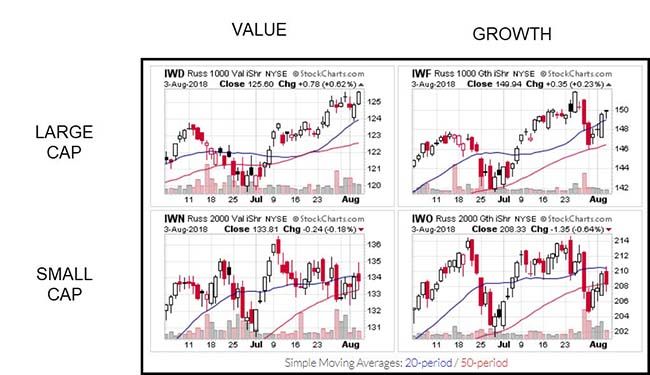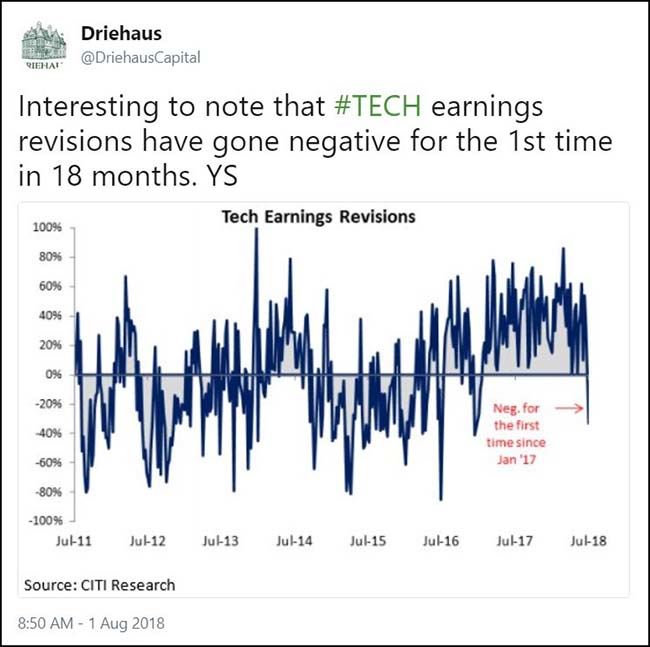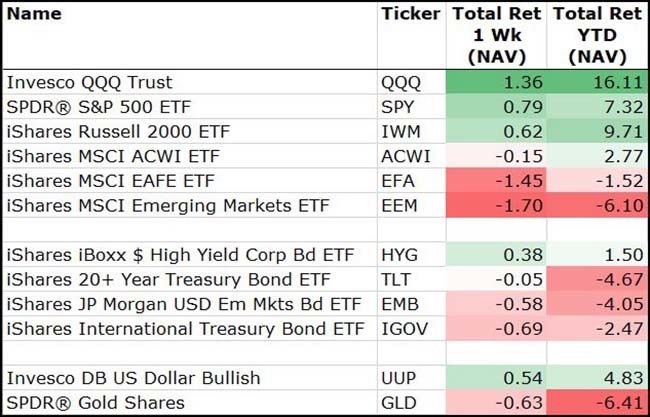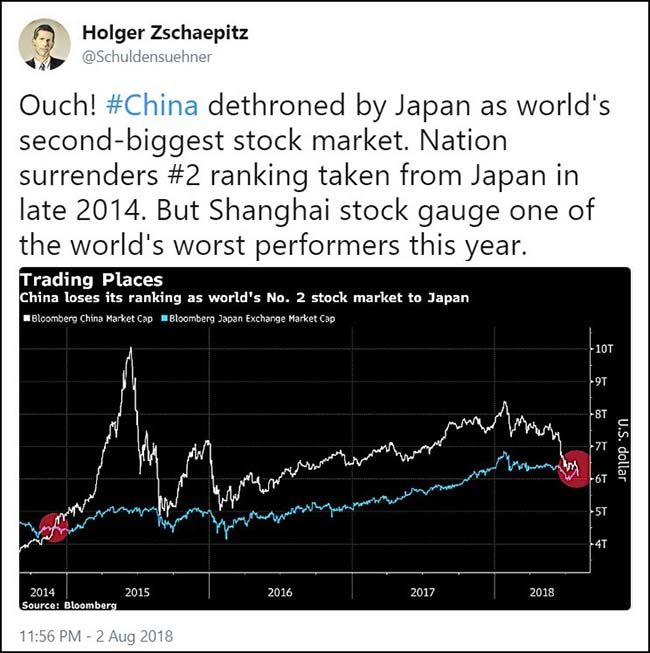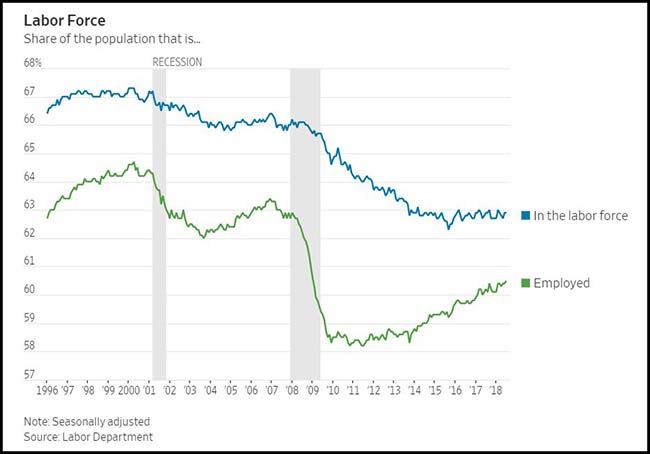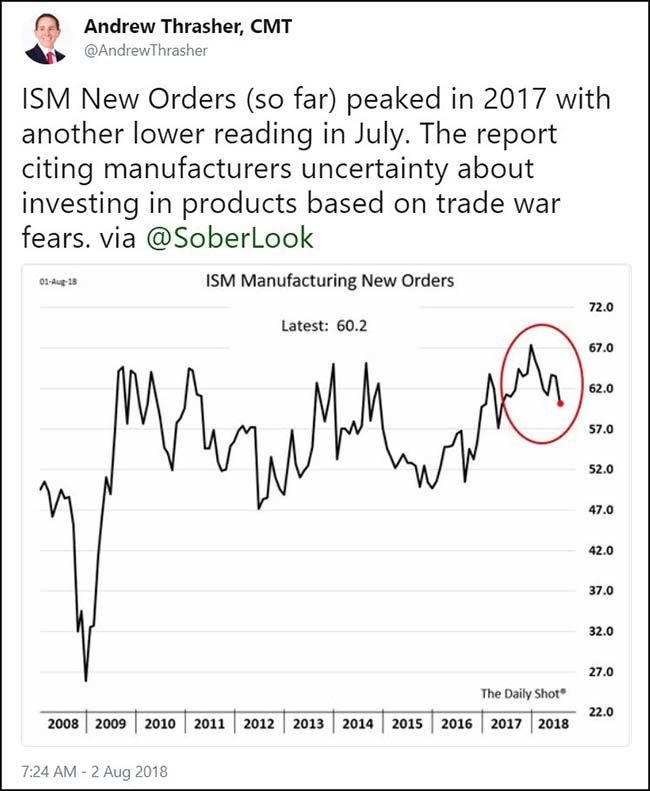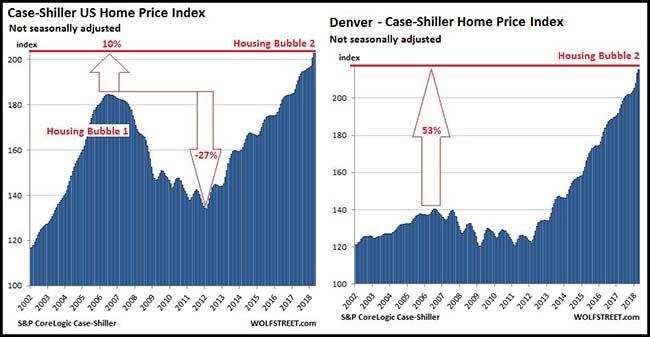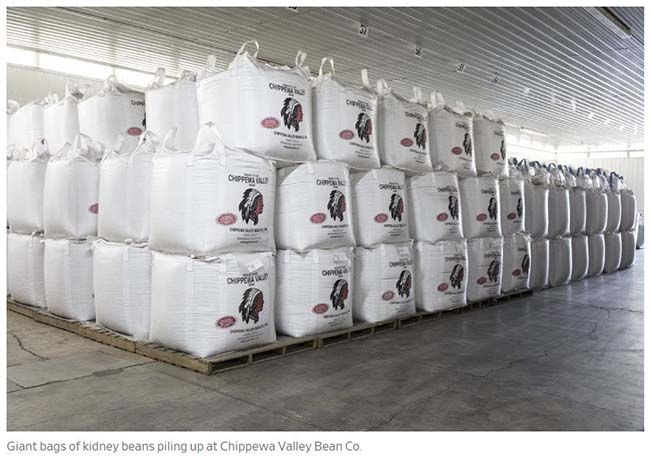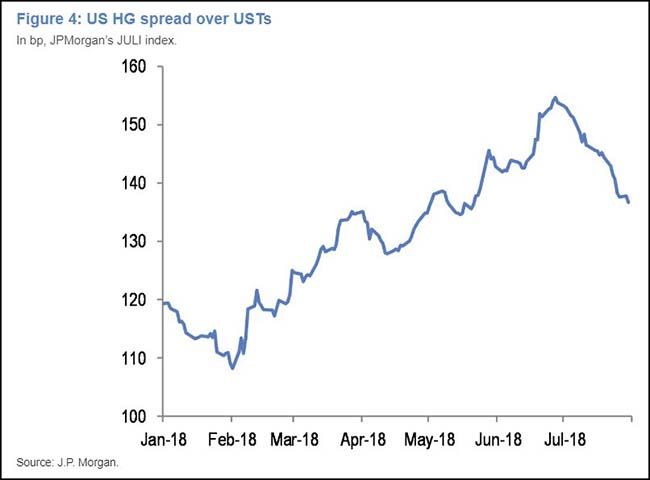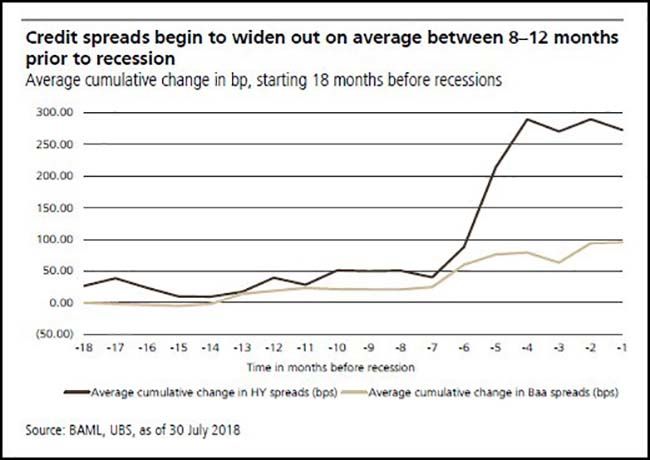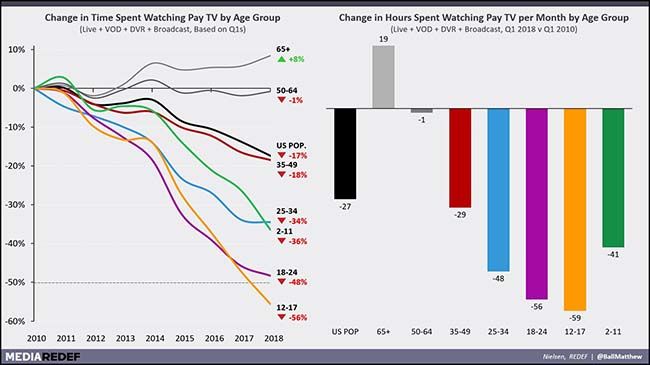by Blaine Rollins, CFA, 361 Capital
Some more interesting moves in the markets last week. Can you recall a time when the market was nearing new highs while REITs, Staples, Healthcare and Utilities all outperformed? Meanwhile Energy, Industrials and Financials underperformed. U.S. junk bonds and high grade credit risks are outperforming at the same time that emerging market currencies and lumber prices are jumping off of the high dive. Japanese bond yields continue to rise as the Bank of Japan gets comfortable with higher rates. U.S. economic data remains better than the rest of the world’s economies, which is buoying the Dollar. And inflation datapoints and guidance will continue to push the Fed to raise rates several more times. Maybe now is a good time to talk about the $700-800 billion that the U.S. Government needs to borrow in the last 6 months of 2018. This amount is 50% greater than what was borrowed a year ago. This money will need to come from somewhere and given the current global trade rhetoric, I am guessing that more of it will need to be financed by U.S. sources. This means that other bonds, stocks, real estate, etc. will need to be sold to buy Treasuries. Investors will be watching closely to see what is sold while at the same time the U.S. Treasury will be watching to see what yields it will take to move all of the inventory.
So strong economic data, earnings, and inflation. Are we moving into the later innings of this economic cycle ballgame? If so, it makes perfect sense why investors are beginning to rotate into more defensive names and sectors. Definitely easier to own consumer staple products stocks when they are raising prices 4-6%. Just keep those diaper factories running at 100% and make sure those truck drivers show up to get it to market.
Some great earnings numbers last week. Above average stock price movements tell you that the analysts are having a tough time nailing down the estimates. Just too many moving parts on the cost side of the equation. And now the revenue guesstimate game will get very difficult if entire geographies pause their orders for global trade reasons. Okay, let’s look at some of the more interesting items from last week…
To receive this weekly briefing directly to your inbox, subscribe now.
Look at what is leading the market higher right now…
If you are a Growth or High Beta stock investor, you might want to be sitting down right now. It doesn’t get much more Defensive then REITs, Healthcare and Consumer Staples. Take a closer look at the charts of some of the big cap pharma stocks. Maybe now you know where that Facebook money has gone to.
Proof that Apple, Inc. is a Defensive stock?
Apartments, drug prescriptions, toilet paper and the iPhone X…clearly you missed the memo. Seriously Apple, nice numbers and excellent stock repurchases.
Speaking of Apple’s repo…
So looking at the charts, I see Large Cap Value breaking out…
But interestingly, no clear leader in Small Cap among Growth or Value. Seems like Small Value should also follow but we will have to keep watching this race.
Maybe time for Technology stocks to take a backseat if their earnings revisions are now declining?
Earnings could get more challenged for the Tech sector if the trade war with China continues…
@sallyshin: S&P 500 companies with exposure to China from @GoldmanSachs
The Defensive Factor is the Cleveland Browns of equity styles…
Near the worst performing factor in 10 of the 11 past years. Reversion to the mean cannot be completely dead, right? Who wants to bet that the Defensive factor can again return to greatness before the Browns make the playoffs?
Looking more broadly at the asset classes last week showed Apple and Amazon’s help to the Nasdaq…
Really it was a U.S. Dollar driven market with the International exposures in the red as the Dollar gained a half a percent.
Looking overseas, Japan passed China to retake the #2 slot…
One effect of the Defensive rotation is that fewer stocks are making new highs…
@DavidInglesTV: For those out there who are getting overly excited over the S&P 500, this one’s for you. Less than 3% of the index is at a new 52-week high.
A price-to-sales chart to consider…
What a great chart this is. Less than 2.5% of Americans are without a job.
Could the trade wars now be impacting the ISM Manufacturing data?
Several important inflation notes in the ISM Manufacturing Survey detail…
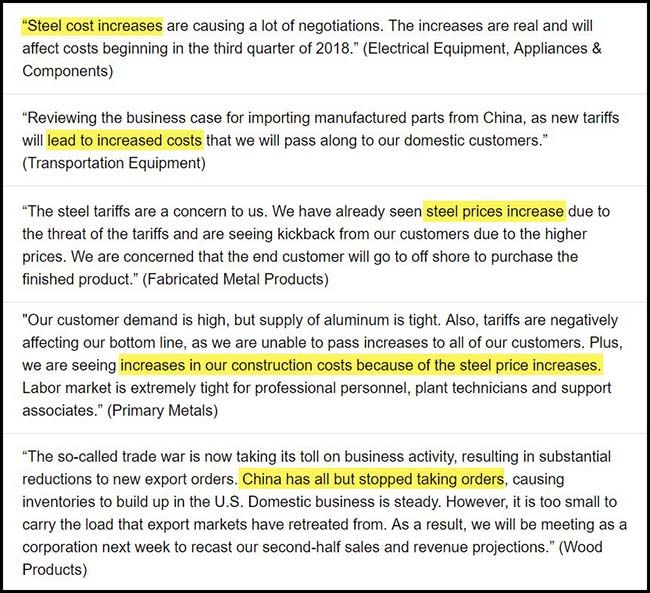
(ISM)
Plenty of inflationary news on the tape from companies raising prices….
Effective September 4, 2018, or as contracts allow, H.B. Fuller North America will implement price increases for all polymer and water-based adhesives product categories. Increases will be between 7 percent and 12 percent. These increases will affect products in the company’s packaging, durable assembly, construction and paper converting segments.- The past 12 months have seen continued increases in raw material feedstock, logistic and labor costs. Raw material inflationary pressure exists globally due to tight supply in a robust demand environment. In North America, the added impact of truck shortages and low unemployment also is affecting costs.
(TradeTheNews.com)
And more strong inflation data in the earnings releases…
@conorsen: Cheesecake Factory’s now seeing wage growth of 6-7%, up from almost 6% last quarter. $CAKE
And of course P&G’s big news last week which helped the Consumer Staples stocks…
P&G, the purveyor of Charmin toilet paper, Bounty towels and Puffs tissues, said on Tuesday that it had recently begun notifying retailers of a 5-percent average price increase on all three brands. The company said it had also started rolling out an average 4-percent price increase on Pampers diapers in North America…
The price of hardwood pulp, an ingredient in tissues and toilet paper, has surged by about 60 percent since late 2016, according to the Pulp and Paper Products Council, which tracks prices based on global customs data. The price of softwood pulp, used in diapers and sanitary pads, jumped by 21 percent during that period.
(Reuters)
ISM Services survey also showed some weakness…
Citi’s U.S. Economic Surprise Index usually has a summer bounce. But not this year…
Consumer Sentiment surveys show more interest in the Now than in the Future…
If anyone could perfectly forecast the next 12 months for me, I would be most grateful.
If consumers are living in the Now, then they must be too busy driving their cars than buying new cars…
As for houses, affordability is beginning to really bite the middle segment of the U.S. housing market…
Expectations were approaching ebullience heading into this spring’s U.S. home-selling season. The National Association of Realtors entered the year expecting home sales to grow by 3.7 percent in 2018 after last year’s lackluster 1.1 percent increase. But now, the NAR’s chief economist has tempered his call with existing homes changing hands at the slowest pace since September and new home sales having fallen to the lowest level since October 2017…
There are other factors that have hamstrung the housing market in 2018 besides record-high home prices. Mortgage rates for 30-year fixed loans are up by more than 0.8 percentage point on average. Separately, the new tax law limits all state and local income taxes and property taxes that can be deducted to $10,000.
Affordability is even more elusive among middle-tier income earners, who tend to be in the market for move-up homes after they’ve outgrown their starter home. And that’s in second-tier markets. In the nation’s costliest cities, median home prices often exceed the wherewithal of most regardless of how much they make. In San Francisco, average home prices exceed $1.6 million.
Housing data is even slowing in the top tier markets…
Home sales have slowed down this year in the Hamptons, the Long Island beach communities that serve as a summer playground for the wealthy of New York, bringing the median price below the $1m mark.
Second-quarter sales fell 12.8 per cent from 2017 levels, according to data prepared for Douglas Elliman by Miller Samuel Real Estate. The median price dropped 5.3 per cent to a $975,000, compared with $1.03m a year earlier.
The spring selling season is usually the high point of the year in the Hamptons, so the drop is stoking concerns that the resort areas of Long Island’s south shore are succumbing to the pressures depressing property activity in other parts of the US.
Rising mortgage rates are increasing costs for homebuyers of all stripes. Higher-end properties have been affected by the 2016 federal tax reform, which imposed new limits on the deductions of mortgage interest and state taxes — the latter a particular concern in high-tax New York.
New price data shows the average U.S. home now 10% above the last bubble…
And for all of my Denver readers who have never experienced a housing bear market, you are up 53%.
Lumber prices have corrected nearly 30%…
As you might expect, the bottom in treasury yields (and thus mortgage yields) came first. Then housing stocks reacted second.
The tariffs are still hurting many U.S. businesses…
After the U.S. placed tariffs on European steel and aluminum in June, Europe hit back with a tax that, among other things, made American kidney beans 25% more expensive in Europe.
Now, Cindy Brown is running out of room to store the beans. One-ton bags of them cover the floors in her cavernous warehouses. Smaller sacks are piled on wood-pallet shelves. Kidney beans fill tall steel bins that dot the grounds.
Chippewa Valley Bean Co. had been on track to ship to Europe 60% of its beans traded internationally this year, worth $25 million. Now, “we’re just sitting on our hands,” said Ms. Brown, president of the family company.
The Fed didn’t hike at last week’s meeting, but Tim Duy sees at least two and probably three hikes on the horizon…
The U.S. economy performed about as well as might be expected in the first half of 2018, growing at an average pace of 3.15% in a “new normal” world where the longer-term speed limit might be just 1.8%. Indeed, in an otherwise fairly unchanged statement, the Fed hailed the results as a “strong” pace of growth at the conclusion of this week’s FOMC meeting, an upgrade from last meeting’s “solid.”
But that is all in the rear view mirror now. As we all plunge deeper into the second half of 2018, the focus is on a potential slowdown in the wake of trade wars, higher labor and material prices, a moderation in the housing market, and the lagged impact of rate hikes. Will those factors be sufficient to give the Fed room to pause as central bankers approach their estimates of the neutral policy rate? At this juncture, it still looks likely that the Fed delivers rate hikes in September and December and probably into March of next year before they will entertain the notion of an extended pause. Their willingness to entertain that notion, however, will of course be data dependent.
While Jamie Dimon wants you to consider 5% interest rates…
Not content with a previous warning investors should brace for U.S. yields of 4 percent, Jamie Dimon went one further at the weekend, suggesting 5 percent was a distinct possibility.
The JPMorgan Chase & Co. chief executive officer said Saturday people should be prepared to deal with the benchmark 10-year bond yield at 5 percent or higher.
“I think rates should be 4 percent today,” Dimon said Saturday at the Aspen Institute’s 25th Annual Summer Celebration Gala. “You better be prepared to deal with rates 5 percent or higher – it’s a higher probability than most people think.”
Hopefully the Federal Reserve and the U.S. Treasury have separate holiday parties…
Otherwise extra security and only plastic knives might be required. While the Fed raises interest rates, the Treasury needs to sell a ginormous amount of Treasuries. Competing agendas are bound to collide. Will Mnuchin’s or Powell’s Twitter gloves come off first?
In all, the Treasury plans to borrow $329 billion from July through September—up $56 billion from the agency’s April estimate—in addition to $440 billion in October through December. The figures are 63% higher than what the Treasury borrowed during the same six-month period last year.
The Treasury’s Borrowing Advisory Committee, made up of representatives from investment funds and banks, said the size of monthly debt auctions would need to continue ratcheting higher to fund government deficits in coming years.
The rising supply of debt could push up the cost of borrowing as the government seeks to attract investors, though many factors, including the inflation outlook, Federal Reserve decisions and shifting investor appetites for safe securities also play roles in setting interest rates.
The size of U.S. government borrowing in coming years is hanging over the bond market. In addition to the increased spending forecast for the federal government, there is concern about lower tax revenue…
RenMac thinks the Treasury could be the catapult for the VIX…
The Fed is contracting their balance sheet, with a notable pick‐up in pace for July.
In practice, the Fed shrinks its holdings by letting a certain amount of Treasuries and MBS mature. Starting July 1, the Fed is rolling over maturing Treasuries only in excess of stated caps of $24 billion coming due, and $16 billion of MBS coming due.
Treasury and mortgage securities don’t get paid down in a steady, linear fashion every day but in lumps, he points out. As it happened, one of those big redemption weeks came just before the big surge in volatility and swoon in stocks during the week ended Feb. 7. That was when the Cboe Volatility Index, or VIX—the equity market’s so-called fear gauge—spiked, which set off a chain reaction that saw the S&P 500 plunge over 5%.
As it happens, the Fed’s holdings of Treasury securities will decline by $24 billion in the week ending Wednesday. And as you may have noticed, the Nasdaq Composite has been a bit wobbly the past few days, most notably in the FAANG stocks. Any connection?
Even with all the worries for higher Treasury rates, Junk Bond returns have been stellar…
You know that credit spreads are a key worry point for me so as returns on credit are solid, I should stay invested in many areas of market risk.
This high yield credit chart also shows that spreads are backing off from a more worrisome rise…
A good UBS chart showing that credit spreads widen 8-12 months before a typical recession grabs hold…
In credit markets, high yield spreads remain tight relative to historical averages. Widening HY spreads are a key indicator of tight monetary policy because they represent lower-quality borrowers. On average, HY spreads widen into the final year of an expansion, (below). Rising defaults and increasing credit and liquidity risk premiums drive a sharp pullback in the performance of high yield bonds before and during recessions.
(UBS)
Analysts are having a more difficult time predicting earnings. Post-earnings stock moves have become much more volatile as a result…
Goldman strategists say it may be a case where trends in the economy and inflation are making forecasting earnings harder than usual for analysts and companies themselves. While U.S. gross domestic product expanded at the fastest rate in four years in the second quarter, the risk of a global trade war and a Chinese slowdown was also building. “This is a sign that the strong economic environment and accelerating inflation trends has reduced the earnings visibility for company management teams and covering analysts,” strategists led by John Marshall and Katherine Fogertey wrote in a note to clients. “This increases the instance of surprises and drives larger stock moves.”
The Q2 earnings season is mostly behind us for large U.S. companies. And it was another very good one…
To date, 81% of the companies in the S&P 500 have reported actual results for Q2 2018. In terms of earnings, more companies are reporting actual EPS above estimates (80%) compared to the 5-year average. If 80% is the final number, it will mark the highest percentage of S&P 500 companies reporting a positive EPS surprise for a quarter since FactSet began tracking this metric in Q3 2008. In aggregate, companies are reporting earnings that are 4.9% above the estimates, which is also above the 5-year average. In terms of sales, more companies (74%) are reporting actual sales above estimates compared to the 5-year average. In aggregate, companies are reporting sales that are 1.4% above estimates, which is also above the 5-year average.
A deep dive into the U.S. beer industry shows that the industry is pushing price over volume. A dangerous combination…
The beer industry has tried to make up for declining volume by increasing prices. That has helped make whiskey and wine relatively more affordable. Beer prices rose 42% between 2000 and 2017, compared with 11% for wine and 19% for spirits, according to a Brewers Association analysis of data from the Bureau of Labor Statistics.
As sales slide, a sense of crisis has taken hold of the industry. On Wednesday, Molson Coors Brewing Co. reported a 3.1% drop in U.S. second-quarter sales driven by lower volumes of its light beers. Last week, AB InBev—which swallowed SABMiller PLC in 2016 to solidify its title as world’s biggest brewer—also reported U.S. revenue fell 3.1% in the second quarter on lower volumes. On Monday, Dutch brewer Heineken NV reported its U.S. beer volumes declined in the first half, blaming the consumer shift from lager to craft beer and spirits.
Seeing Brazilians flee makes it a bit tougher to want to invest (or vacation) in the country…
Wealthy Brazilians are fleeing the country, terrified by spiraling gun violence and pessimistic about the nation’s political and economic future…About 52% of the richest Brazilians—those with a monthly household income of more than $2,500—want to emigrate, while 56% of college-educated Brazilians want to leave, according to a study published in June by Brazilian polling agency Datafolha. Overall, 43% of Brazilians would emigrate if they could.
“The hope that Brazilians once had in their country has gone out the window, and many people are now reaching the conclusion that things are unlikely to change in the next few years,” said Mr. Menezes Filho.
Brazil’s government has struggled to keep track of how many of its citizens live abroad, but a series of recent studies paint a dismal picture. With the October presidential elections approaching, 41% more Brazilians have registered to vote from abroad than in 2014, according to government figures.
Meanwhile, the number of Brazilians filing emigration notifications with the federal tax office reached 21,700 last year, nearly three times the number in 2011, when authorities began recording the data. Many are moving to exclusive enclaves on the Portuguese Riviera and to U.S. cities such as Orlando and Miami.
For TV video, the U-18 age group remains in a complete freefall…
@ballmatthew: Updated for Q1 2018: Decline in Pay TV usage (inc. OTA broadcast) by demo. 12-17 down 56% (59 hours/month)! 18-24 down 48% (56), 25-34 down 34% (48). Rate of decline still not slowing. If you’re under 50, you’re watching at least 18% less Pay TV than in 2010. Only 65+ is up.
Copyright © 361 Capital









